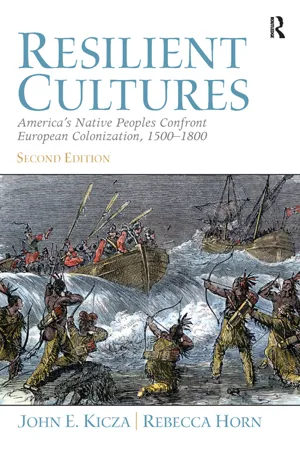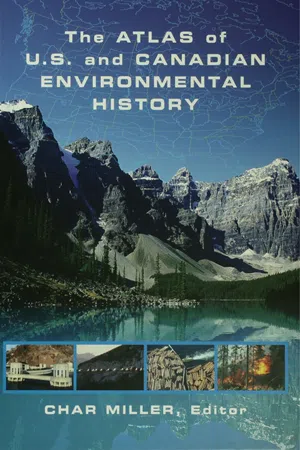History
Environmental Effects of The Columbian Exchange
The Columbian Exchange had significant environmental effects, as it led to the transfer of plants, animals, and diseases between the Old World and the New World. This resulted in the introduction of new species to different ecosystems, leading to changes in biodiversity and the environment. The exchange also contributed to the spread of agricultural practices and the transformation of landscapes.
Written by Perlego with AI-assistance
Related key terms
3 Key excerpts on "Environmental Effects of The Columbian Exchange"
- eBook - ePub
Resilient Cultures
America's Native Peoples Confront European Colonialization 1500-1800
- John Kicza, Rebecca Horn(Authors)
- 2016(Publication Date)
- Routledge(Publisher)
8Enduring Connections between the New World and the OldThe preceding chapters have considered the nature of the native peoples of the Americas and how they were affected by and responded to European colonization. The first part of this chapter examines the impact of the incorporation of the Americas into the environmental and economic frameworks of the Old World, a process commonly termed “The Columbian Exchange.” For the first time, the Atlantic Ocean became a primary arena for the movement of people, diseases, animals, plants, and precious metals. This process transformed the environment of the Americas as much as it did the rest of the world. The following five sections consider the scope and impact of each of these emerging connections between the New World and the Old. A concluding section examines certain lasting patterns and trends in the history of Indian–European interactions in the colonial period.Before the discovery of the Americas, Western Europe participated only episodically in the exchange systems of the Old World. Located on the western periphery of the three continents of Africa, Asia, and Europe that constituted this trade zone, Western Europe produced few commodities or manufactured goods that could compete in African or Asian markets. Hence, it scarcely participated in the dynamic and flourishing trading networks centered in the Indian Ocean and the South China Sea. The complex economies of South Asia and China routinely shipped merchandise to East Africa, throughout Southeast Asia, and to the Spice Islands (modern Indonesia) and the Philippines.The Movement of PeoplesThe Americas had only minimal impact on the Old World in the exchange of people. Few Native Americans journeyed to Europe, and fewer still remained for very long. Europe certainly did not need people from America as settlers or laborers. Early explorers of the Americas, though, frequently kidnapped small numbers of young natives to take back with them. Once in Europe, they displayed the natives to the royal court and the public and also trained them to serve as translators in later voyages to the natives’ regions of origin. Surrounded by dense populations of disease-carrying peoples in Europe’s very different climate, many of these Indians became ill and died soon after their arrival. - Char Miller(Author)
- 2003(Publication Date)
- Routledge(Publisher)
T he Columbian exchange refers to the exchange of plants between the Old and New Worlds and the introduction of animals from Europe to the Western Hemisphere following the arrival of Europeans in the fifteenth century. By introducing a host of crop plants and domesticated animals to their new environment, the Spanish, French, and British settlers attempted to “Europeanize” the North American continent. Beginning with the second voyage of Columbus in 1493, the Spanish introduced wheat, melons, onions, sugarcane, grapevines, radishes, chickpeas, cauliflowers, cabbages, and lettuce, as well as horses, cattle, swine, sheep, goats, and chickens. This voyage began the exchange of plants and animals between the New and Old Worlds that would have significant effects on the environments and ecologies of both worlds.Diseases. The Columbian exchange also spread Old World diseases, such as smallpox, influenza, and measles, among the indigenous populations—none of which had immunity to those diseases. Along the Atlantic coast of Canada, for example, fishermen and fur traders exposed indigenous peoples to European diseases during the early sixteenth century. During the seventeenth century, diseases decimated Native American populations in present-day New England, while during the eighteenth century Russian explorers spread diseases among the Aleut, Eskimo (Inuit), and Tlingit in the Pacific Northwest. Although the Old World diseases introduced in the New World were often catastrophic to indigenous populations, the Columbian exchange brought nutritional benefits and improved food supplies with the addition of new crops and new animal species.The exchange of flora between the New and Old Worlds was extensive by the seventeenth century. By the late eighteenth century, many agricultural plants had been traded, particularly between the Western Hemisphere and Europe and Africa. Although some native animals from the New World, such as turkeys and llamas, were introduced in Europe, the exchange of fauna for agricultural purposes was primarily from Europe to the New World.Sources: James Lang, Notes of a Potato Watcher (College Station: Texas A & M University Press, 2001), 21; Elaine N. McIntosh, American Food Habits in Historical Perspective (Westport, Conn.: Greenwood Press, 1995), 65; and The Columbian Biological Exchange. Dr. Harold D. Tallant, Department of History, Georgetown College. 3 Dec. 1998. <http://spider.georgctowncollege.edu/htallant/courses/his111/columb.him- eBook - ePub
Virtual History
How Videogames Portray the Past
- A. Martin Wainwright(Author)
- 2019(Publication Date)
- Routledge(Publisher)
The presence of coffee and sugar in Central America today tells an important story. It’s the story of the “Columbian Exchange,” the transfer of people, commodities, and diseases between the Old and New Worlds, and among regions of both groupings of continents, in the centuries following Columbus’s opening of regular contact between the Americas and Afro-Eurasia. This story is a central focus of modern historical analyses pertaining to European expansion, and European expansion is one of the major themes of Europa Universalis, as well as other grand strategy games that cover the period, including Sid Meier’s Civilization. In fairness to Paradox, the development team includes the Columbian Exchange as an “institution” that modifies productivity in Europe. This institution is supposed to emulate the effect of certain commodities, such as potatoes, in the European diet. However, this level is much more abstract than, for instance, having Europeans find a Central American territory producing chocolate (a New World crop) and turning it over to coffee cultivation. That neither the Europa Universalis nor Civilization series highlight the Columbian Exchange is evidence of at least two potential challenges to portraying the impact of humans on the environment and vice versa. One is the limitations inherent in making commercial videogames simple enough to attract a large market. The other is the extent to which game designers consider environmental aspects of history to be a priority. These challenges are important because human interaction with the physical environment has played an increasingly important role in the work of historians and other scholars dealing with the past. This chapter examines how well videogames deal with environmental issues while explaining how scholars have argued that the environment and human history are interconnected
Index pages curate the most relevant extracts from our library of academic textbooks. They’ve been created using an in-house natural language model (NLM), each adding context and meaning to key research topics.


